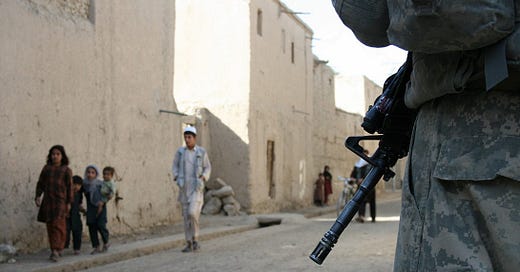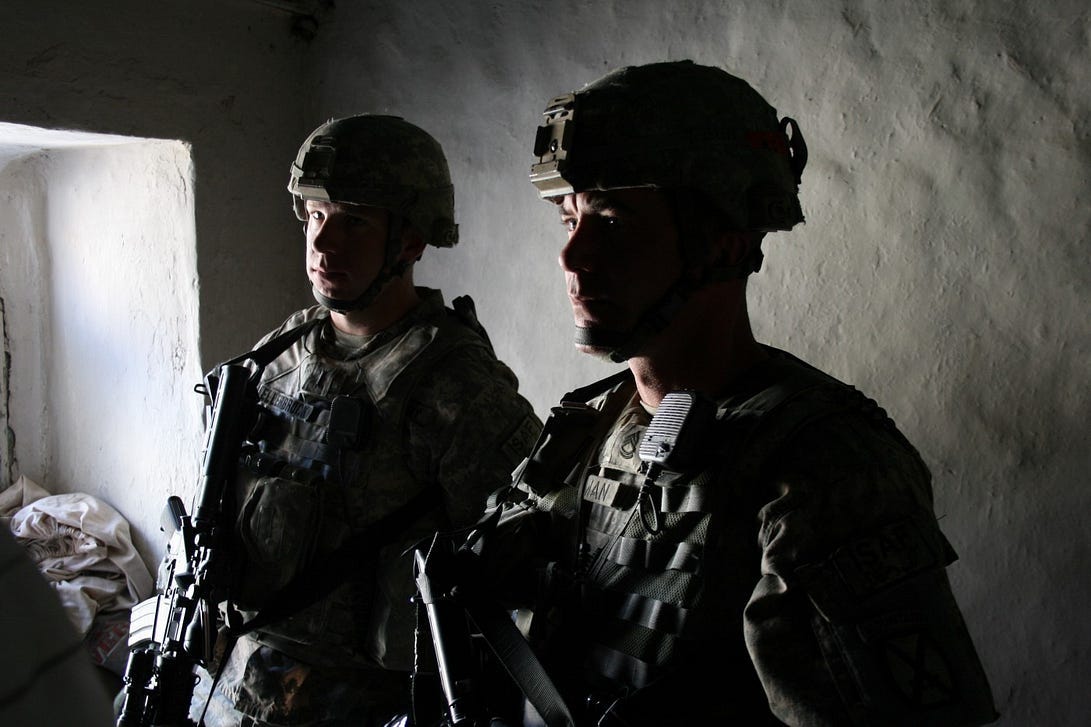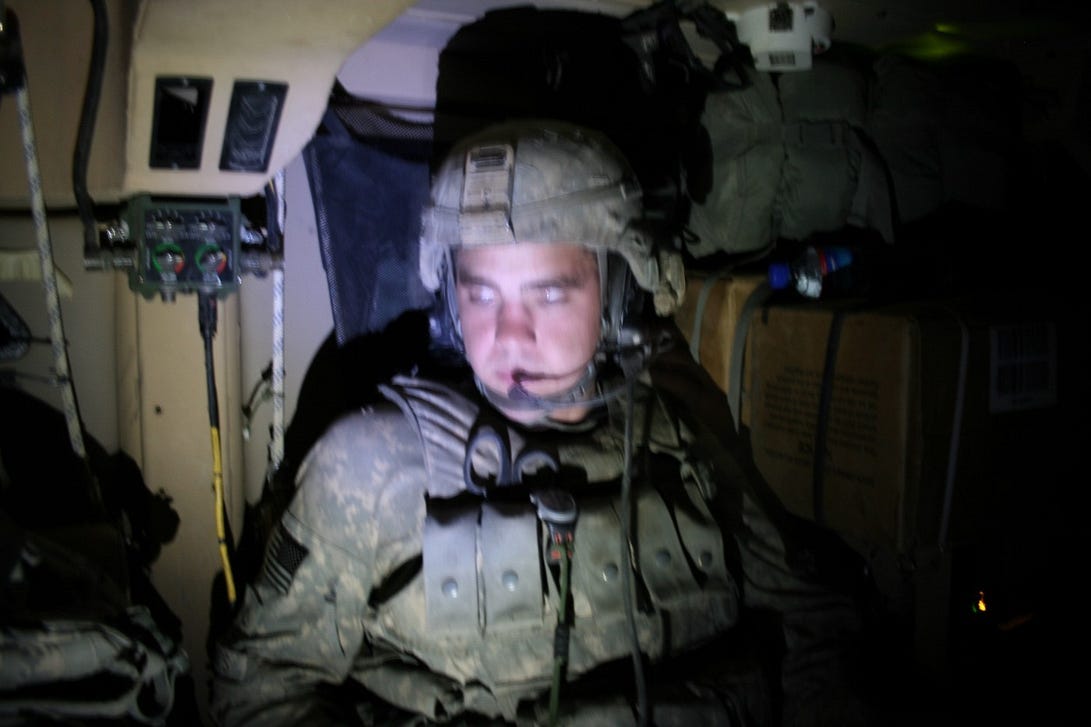It started with a threat. At a checkpoint in Baraki Barak district in October 2009, Afghan security guards protecting the American combat outpost stopped a driver. When they insisted on searching the car, the driver rankled. “Fine,” he said, “you won’t be here in two days, anyways.”
At the outpost, soldiers speculated. Maybe the driver meant he would try to get the Afghan guards fired. Maybe he was hinting at a planned attack on the outpost. Maybe something else, something more dangerous for the roughly 100 Americans in Baraki Barak.
Two days later, Able Troop’s 3rd Platoon rolled into a district village to check up on some mosque refurbishment projects. As 1st Lt. Kevin Ellerbrock chatted up the village mullahs, a worried-looking man approached the soldiers guarding the platoon’s vehicles, idling on the main road through the village. The man spoke only a little English and the soldiers spoke no Dari; the platoon’s interpreter was with Ellerbrock.
The man said he was a doctor. He gestured to the trucks. He spoke urgently. The soldiers decided the doctor was trying to say one of two wildly divergent things: 1) There was a bomb in the road, or 2) He had an appendicitis patient in his car, and the Americans were blocking the way. Just to be safe, the soldiers relayed the bomb threat to the rest of the platoon. But no one took it too seriously.
Night fell around six. The platoon climbed into its trucks and trundled down a dirt road back towards the outpost. In a flash, the second truck in the convoy exploded. The front axle sailed into the air; the vehicle sank into a crater. From a tree-line on the right, AK-47s chattered, RPGs streaked out.
The convoy halted around its disabled truck, the vehicle’s occupants dazed but unhurt. They lowered their ramp to make their escape. They could feel rounds cutting through the air. They raised the ramp and sat tight as, all around them, their comrades aimed their weapons at the tree-line and opened fire.
Later, platoon sergeant Donald Coleman laid the blame squarely on his own shoulders—and on the lack of interpreters. “All the signs were there,” he said. “We chose to ignore them.”
Second in line
I was in the first truck in line. The Mine-Resistant Ambush-Protected vehicle, built in 2008 by International Trucks, was fitted with a three-ton mine-roller attached to the front bumper. The roller was only good against pressure mines. The bomb that destroyed the number-two truck was triggered by a command wire trailing back to the tree-line.
I was squeezed between our .50-caliber gunner, Private 1st Class Judas Sanchez, and our two dismounts, Sgt. Jason Ide and Pvt. Matt Hoats, the medic. Within seconds of the blast, Sanchez charged his gun and opened fire. Tracers lanced into the trees, answering the winking AK-47s.
Behind us, we could hear our attached Afghan soldiers firing their own AKs and rockets. The surviving American trucks added their .50-calibers to the clatter. Ide and Hoats poked their heads out the “bitch hatch—a small opening in the MRAP’s roof—and popped off rifle-mounted grenades. Hoats swore: his grenades had fallen short of the trees. Ide would make fun of him all night for that.
“Ammo! I need ammo!” Sanchez cried. Ide passed up a box. Between bursts, Sanchez peered through an infrared sight mounted next to his gun. Ten minutes into the ambush, the Taliban were still fighting. That was unusually brave of them.
The observation post atop a nearby mountain spur turned its weapons and sensors in our direction. A TOW anti-tank missile from the OP burst in the tree-line. Hoats, monitoring the missile shoot with his radio headset, chuckled.
Now 120-millimeter mortars from the outpost added their loud, sharp voices. And Apache helicopters appeared overhead, burping 30-millimeter cannon rounds into the Taliban position. Later, sources would indicate at least four, maybe five, Taliban died in the onslaught. It’s hard to tell, because the Taliban always drag away their dead.
Rockets missed us and exploded in the field on our left side, setting the grass and weeds on fire. A cow died in the crossfire. On the radio, someone noted that the dead cow, more than the gunfire, would really piss off the local residents.
I tried to capture the fighting with my video camera, but I was hemmed in by soldiers and gear crammed into our MRAP. Unable to peer outside, I turned my camera towards Ide and Hoats. I heard singing and realized my iPod—the model with the external speaker—was still playing. I’d been listening to it at the moment the Taliban triggered the bomb.
I recognized the singer. I realized, in horror, that it was Avril Lavigne—just about the least appropriate accompaniment for a firefight. In my defense, the Avril Lavigne song came with my Scrubs Season 3 soundtrack. It’s not like I’m a huge Avril fan or anything. I fumbled with my iPod and switched it off. Sanchez opened up again on the Taliban one last time as, around us, the shooting subsided.
“They were expecting us,” Ide breathed as he settled into his seat.
Hidden danger
The bomb that destroyed the number-two truck was probably a couple hundred pounds in weight. It was command-wire-detonated and buried in the soft earth in the middle of the road. Sometimes the Taliban buries secondary bombs to kill any soldiers climbing out of damaged trucks. This time, they did not.
In the hours following the attack, 3rd Platoon became the focus for the entire troop. A Counter Improvised Explosive Device investigative team arrived with a bomb-sniffing dog. A wrecker crew mobilized at the combat outpost and headed our way, only to turn back with a malfunctioning truck.
It took more than five hours for the wrecker crew to get its gear working and reach the kill zone. By then, the crew of the damaged truck had taken refuge in a nearby house with a gaggle of frightened Afghans. Ide and Hoats climbed out of my truck to help recover weapons and secret technology from the damaged vehicle. They crammed it into sacks and tossed it on my lap.
For some reason, all the fighting had made me hungry. I reached for Hoats’ bag of snacks and shamelessly wolfed down two packets of crackers and some candy-coated peanuts. I had to pee, so I found an empty bottle and improvised. A cold, cold wind blew in from the gunner’s hatch. Sanchez did not complain. I did.
It was time to leave. But we had to turn the convoy around to avoid the fresh crater. Our driver, Private 1st Class Mike Meersman, eased our MRAP off the narrow road to make a u-turn. The 15-ton vehicle with the three-ton mine-plow sank like a stone into the irrigated field. The combined efforts of two towing MRAPs—and of several shivering soldiers chopping down a tree that stood in our way—couldn’t get us back onto the road. The wrecker, already hauling the ruined number-two truck, had to loop around to rescue us, too.
In addition to killing a cow, we destroyed a field, a culvert and a tree in the kill zone, and damaged a bridge on our way home. Our State Department rep back at the outpost, Ron Barkley, assured me the local farmers would take plenty of pictures of the damage and file claims.
It was past three in the morning when we got back to base. The battle had lasted 20 minutes. The recovery took some eight hours. By the end, I was cramped, cold, hungry, thirsty and bored. I can only imagine how 3rd Platoon felt.
Climbing out of our MRAP, I muttered something appreciative to Ide and Hoats then shuffled to my tent. I peeled off my armor and boots, dumped my cameras on my little wooden desk, guzzled a bottle of water and fell into bed with my cell phone. In my head I listed all the people I should call, to tell them I love them.







